Site Characterization of the Palencia Cathedral (Spain): Origin of Recurrent Phreatic Floods in the Crypt of San Antolín
Abstract
1. Introduction
2. Geological Setting
- (1)
- The Dueñas Unit (Lower–Middle Miocene), which outcrops between 700 m a.s.l (riverbed) and 750–760 m a.s.l. It has a visible thickness of 50–60 m since its lowest part does not crop out in the area. Levels of clays, marly clays, marls, and macrocrystalline gypsum are the predominant lithologies. Within the clay levels, smectite and illite are the most abundant minerals, with kaolinite and palygorskite in lower proportions. These materials were formed under lacustrine and palustrine environments.
- (2)
- The Tierra de Campos Unit (Middle Miocene) comprises silts, sands, and clays, with some sandy and gravelly beds. Their ochre color is easily recognizable between the grey, green, and white colors of the other lithologies. In the central part of the CDB, this unit has a thickness of 30 m, decreasing towards the margins. The clay content is very low, with a predominance of illite and kaolinite, as well as some traces of chlorite. In the sandy levels, quartz and feldspar are dominant. The carbonate content is below 10%, in contrast with the 40–50% found in the other lithologies. This unit is interpreted as an expansion of fluvial sediments over lacustrine deposits.
- (3)
- The Cuestas Unit (Middle–Upper Miocene) was deposited in a dry/saline mud flat–ephemeral saline lake system, and contains marls, marly clays, gypsum, limestones and dolostones, reaching a thickness of more than 80 m. Organic matter levels are frequent in the transition zone with the Tierra de Campos Unit.
- (4)
- Quaternary deposits are restricted to large-scale alluvial deposits and fluvial terraces, which may lie between 5 and 180 m above the present thalweg [11].
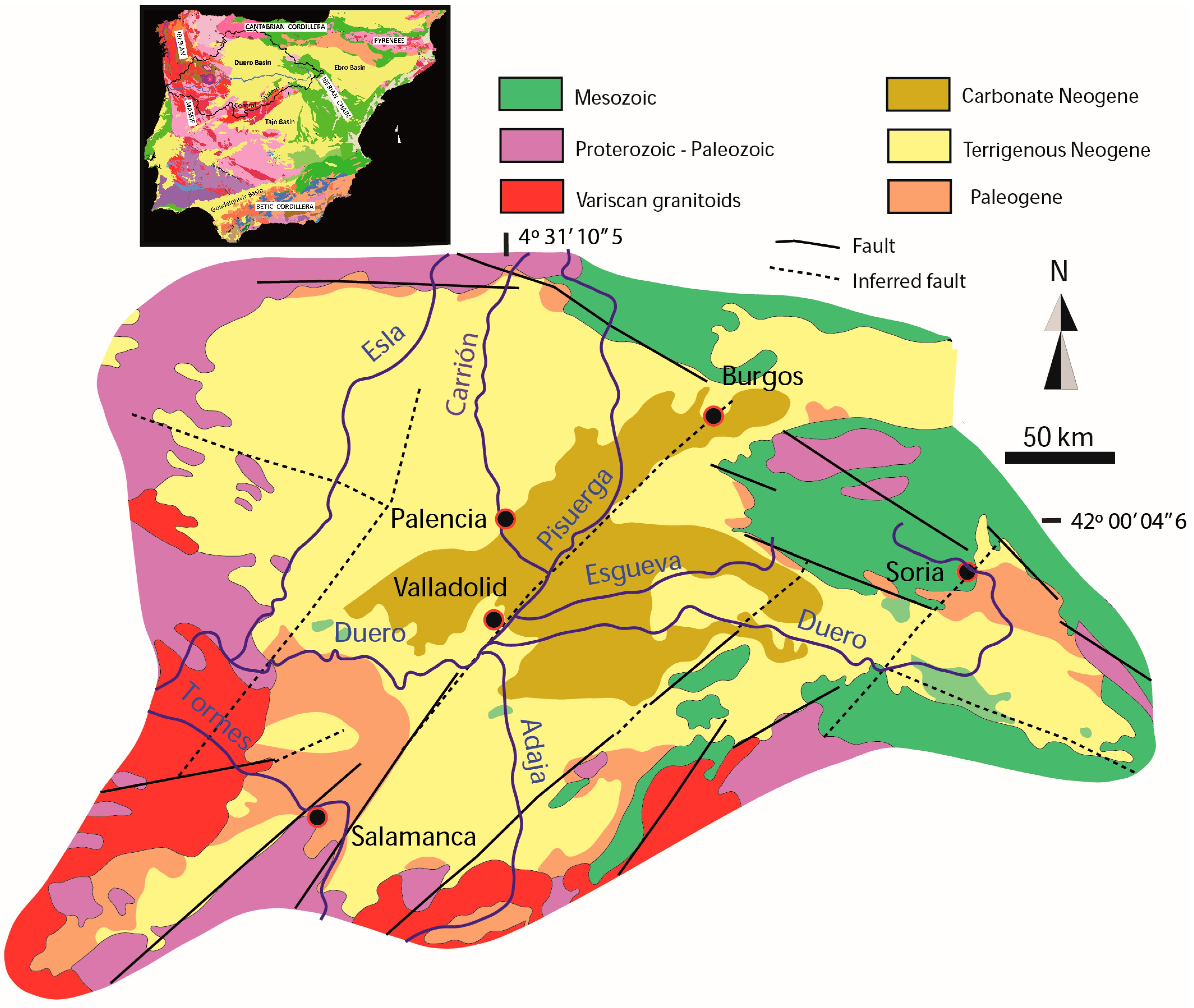
3. Materials and Methods
3.1. Topographic Mapping
3.2. Geological-Geotechnical Prospections
3.3. Electrical Resistivity Tomography (ERT)
4. Characterization of the Problem and Results of the Investigation
4.1. Flooding of the San Antolín Crypt
4.2. Topographic Mapping Results and Insights
4.3. Geological-Geotechnical Characterization
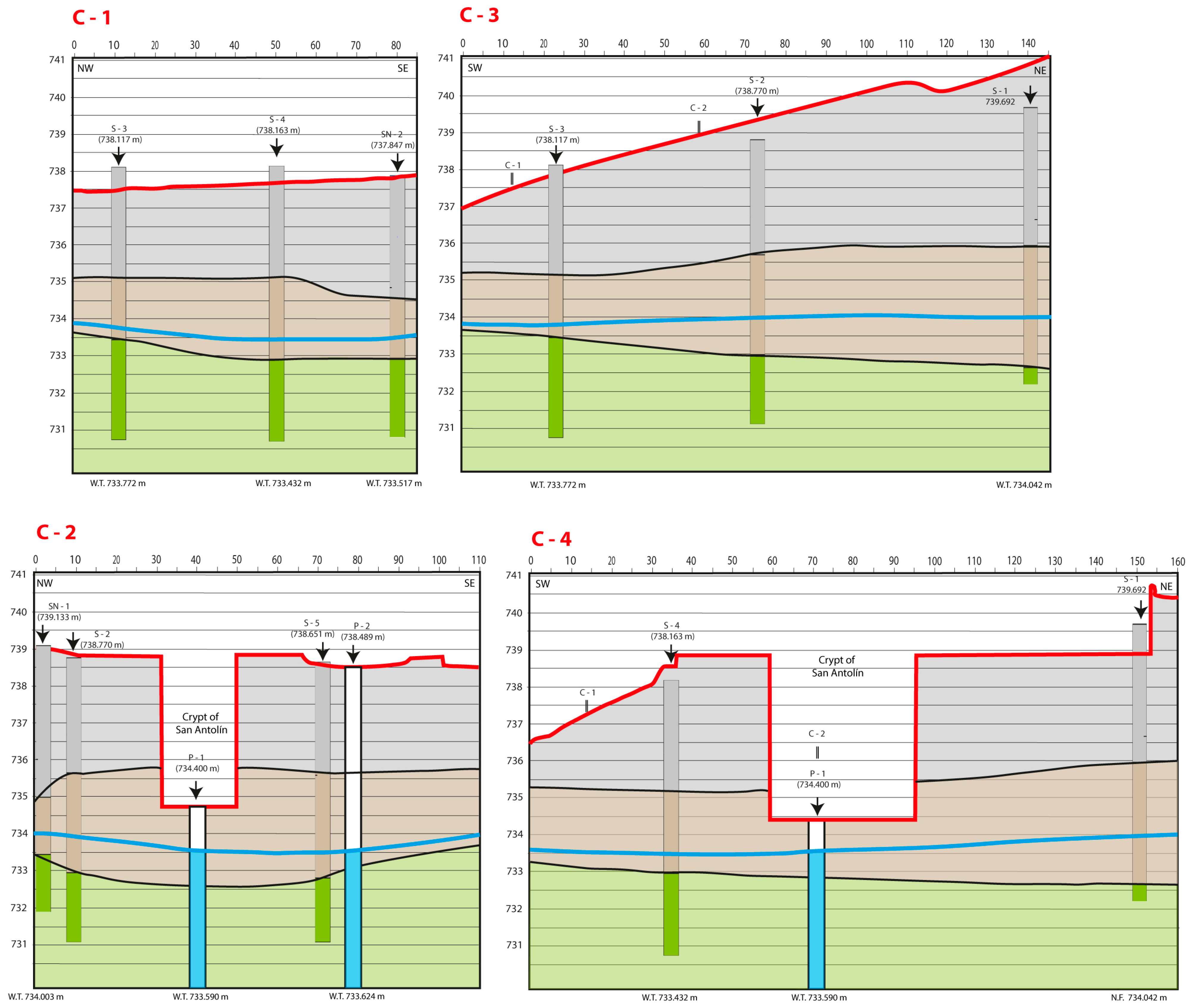
4.4. Geophysical (Resistivity) Characterization: Results from the ERT Profiles
5. Discussion
5.1. Aquifer Arrangements and Factors Altering Them
5.2. Input from Satellite Images on the Humidity Levels Around the Cathedral
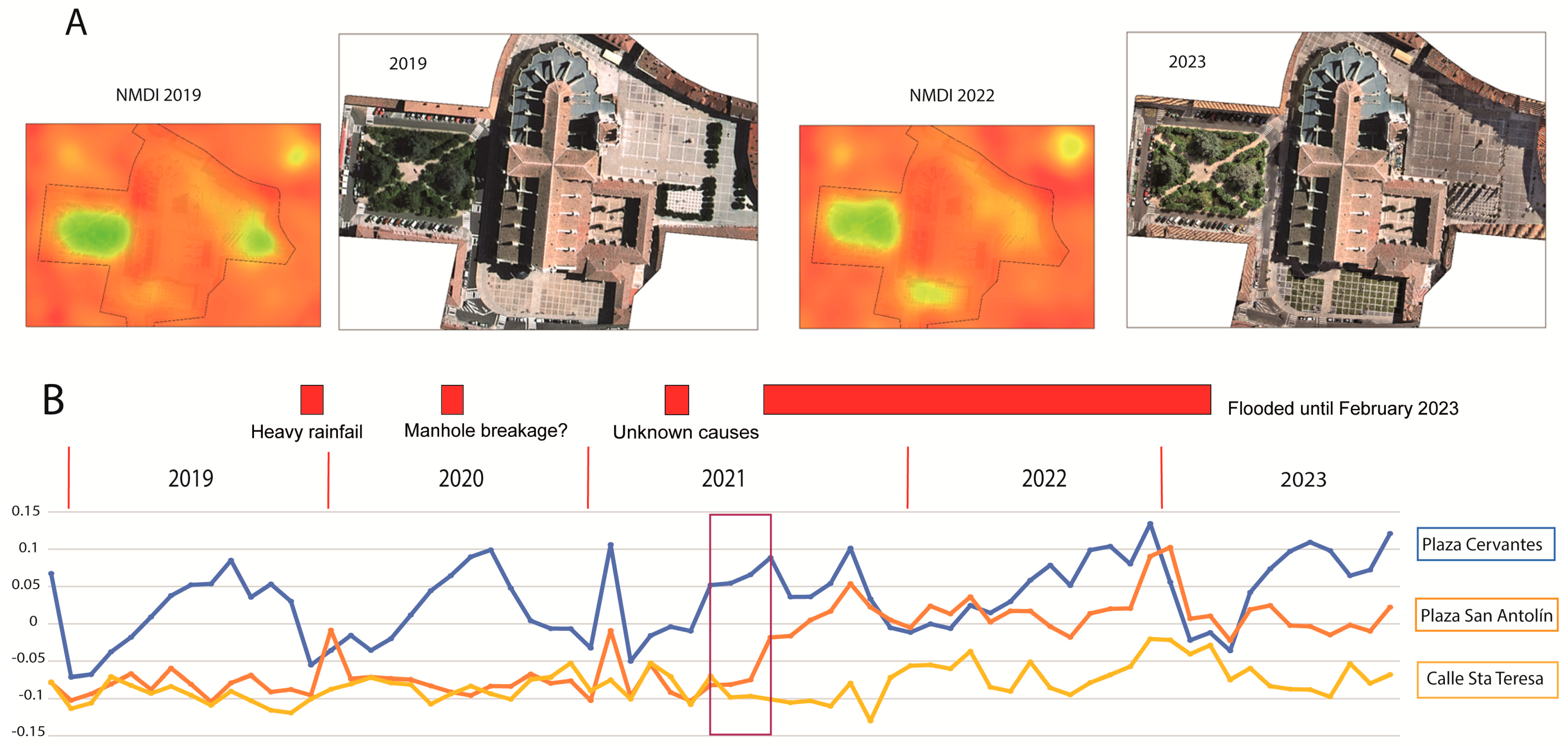
5.3. Solutions for and Evolution of the San Antolín Crypt’s Phreatic Floods
6. Conclusions
- (1)
- The first level consists of anthropogenic fillings ranging in thickness from 3 to 4 m. At its base there is a “black level” rich in organic content and with low permeability, constituting a water retention level. This level is not continuous, as it was not detected in some areas of Plaza de San Antolín during the conducted surveys.
- (2)
- The natural stratigraphic sequence begins with a deposit of gravels and sands constituting one of the high Pleistocene terraces of the Carrión River. Its thickness is also variable, generally decreasing as it approaches the river. These are highly permeable materials where the main aquifer in the area is located.
- (3)
- Clays and marls from the Miocene, belonging to the Dueñas Unit. This level is water-saturated and has very low permeability. The depth at which the top of this level is located varies, usually between 5 and 7 m. It is worth noting that its top is not horizontal but presents an undulating shape, defining a basin-like geometry in the subsurface of the San Antonín Crypt.
Author Contributions
Funding
Data Availability Statement
Conflicts of Interest
References
- Pérez-Gracia, V.; Caselles, J.O.; Clapes, J.; Osorio, R.; Martínez, G.; Canas, J.A. Integrated near-surface geophysical survey of the Cathedral of Mallorca. J. Archaeol. Sci. 2009, 36, 1289–1299. [Google Scholar] [CrossRef]
- Giocoli, A.; Hailemikael, S.; Bellanova, J.; Calamita, G.; Perrone, A.; Piscitelli, P. Site and building characterization of the Orvieto Cathedral (Umbria, Central Italy) by electrical resistivity tomography and single-station ambient vibration measurements. Eng. Geol. 2019, 260, 105195. [Google Scholar] [CrossRef]
- Benson, R.C.; Yuhr, L.B. What Is Site Characterization. In Site Characterization in Karst and Pseudokarst Terraines; Springer: Dordrecht, The Netherlands, 2016. [Google Scholar] [CrossRef]
- Carpinteri, A.; Lacidogna, G.; Manuello, A.; Invernizzi Binda, L. Stability of the vertical bearing structures of the Syracuse Cathedral: Experimental and numerical evaluation. Mater. Struct. 2009, 42, 877–888. [Google Scholar] [CrossRef]
- Roje-Bonacci, T.; Miscevic, P.; Salvezani, D. Non-destructive monitoring methods as indicators of damage cause on Cathedral of St. Lawrence in Trogir, Croatia. J. Cult. Herit. 2014, 15, 424–431. [Google Scholar] [CrossRef]
- Zmudzinski, Z. Changes of engineering geological conditions and their influence on buildings in the Historical Centre of Cracow. In The Engineering Geology of Ancient Works, Monuments and Historical Sites: Preservation and Protection, Proceedings of the International Symposium Organized by the Greek National Group of IAEG, Athens, Greece, 19–23 September 1988; Marinos, K., Ed.; Balkema: Rotterdam, The Netherlands, 1988; Volume 1, pp. 495–502. [Google Scholar]
- Makedon, T.; Chatzigogos, N.P.; Spandos, S. Engineering geological parameters affecting the response of Thessaloniki’s urban fill to a major seismic event. Eng. Geol. 2009, 104, 167–180. [Google Scholar] [CrossRef]
- Moscatelli, M.; Pagliaroli, A.; Mancini, M.; Stigliano, F.; Cavuoto, G.; Simionato, M.; Peronace, E.; Quadrio, B.; Tommasi, P.; Cavinato, G.P.; et al. Integrated subsoil model for seismic microzonation in the Central Archaeological Area of Rome (Italy). Disaster Adv. 2012, 5, 109–124. [Google Scholar]
- Alonso-Gavilán, G.; Armenteros, I.; Carballeira, J.; Corrochano, A.; Huerta, P.; Rodríguez, J.M. Cuenca del Duero. In Geología de España; Vera, J.A., Ed.; Sociedad Geológica de España: Salamanca, Spain; IGME: Madrid, Spain, 2004; pp. 550–556. ISBN 978-84-7840-546-6. [Google Scholar]
- Yenes, M.; Monterrubio, S.; Nespereira, J.; Santos, G.; Fernández-Macarro, B. Large landslides induced by fluvial incision in the Cenozoic Duero Basin (Spain). Geomorphology 2015, 246, 263–276. [Google Scholar] [CrossRef]
- Antón, L.; Rodés, A.; De Vicente, G.; Pallás, R.; García-Castellanos, D.; Stuart, F.; Braucher, R.; Bourlès, D. Quantification of fluvial incision in the Duero Basin (NW Iberia) from longitudinal profile analysis and terrestrial cosmogenic nuclide concentrations. Geomorphology 2012, 165–166, 50–61. [Google Scholar] [CrossRef]
- Vera, J.A. (Ed.) Geología de España; SGE-IGME: Madrid, Spain, 2004; 890p, ISBN 978-84-7840-546-6. [Google Scholar]
- Portero, J.M.; Gutiérrez-Elorza, M.; Molina, E. Geological Map of Spain, 1:50000, n° 273 (Palencia); Instituto Geológico y Minero de España (IGME): Madrid, Spain, 1982. [Google Scholar]
- Mora, M. Los Palentinos Cumplen con la Tradición de Beber Agua en la Cripta. 2024. Available online: https://www.elnortedecastilla.es/palencia/fiestas/palentinos-cumplen-tradicion-beber-agua-cripta-20240902180633-ga.html (accessed on 2 September 2024).
- CHD (Confederación Hidrográfica del Duero). Datos de Aforo: Estaciones de Palencia y La Nava. 2023. Available online: https://datos.chduero.es/dataset/datos-de-aforos (accessed on 25 September 2023).
- AEMET (Agencia Estatal de Meteorología). Estación Meteorológica de Autilla del Pino. 2023. Available online: https://www.aemet.es/es/datos_abiertos (accessed on 25 September 2023).
- Mínguez, A. La Cripta de la Catedral de Palencia, Víctima de las Lluvias. 2016. Available online: https://www.abc.es/espana/castilla-leon/abci-cripta-catedral-palencia-victima-lluvias201604221925_noticia.html (accessed on 22 April 2016).
- Benito Iglesias, J. Ni Cripta ni Agua Milagrosa el día del Patrono. 2021. Available online: https://www.diariopalentino.es/Noticia/z5c4bfd05-f8e8-9ad3-ac483a5b93e50449/202109/Ni-cripta-ni-agua-milagrosa-el-dia-del-patrono (accessed on 2 September 2021).
- Díaz, J.M. Las Obras de los Entornos de la Catedral de Palencia Culminan con la Plantación de Cincuenta Árboles. La Plaza de San Antolín se Transforma en una Zona Ajardinada para el Descanso. 2021. Available online: https://www.elnortedecastilla.es/palencia/obras-entornos-catedral-20210724141142-nt.html (accessed on 24 July 2021).
- Sentinel Hub EO Browser. 2024. Available online: https://apps.sentinel-hub.com/eo-browser/ (accessed on 19 September 2023).
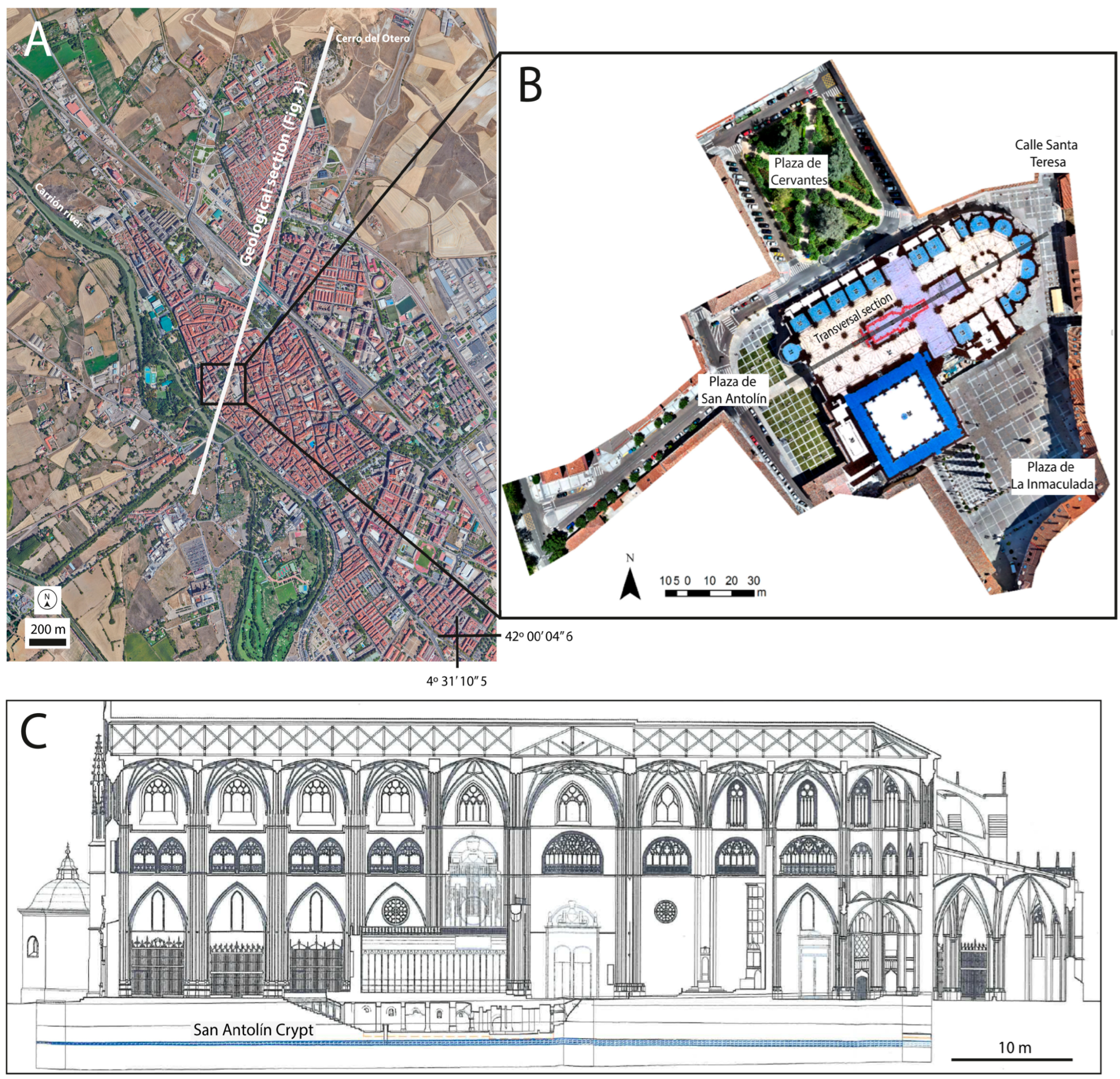

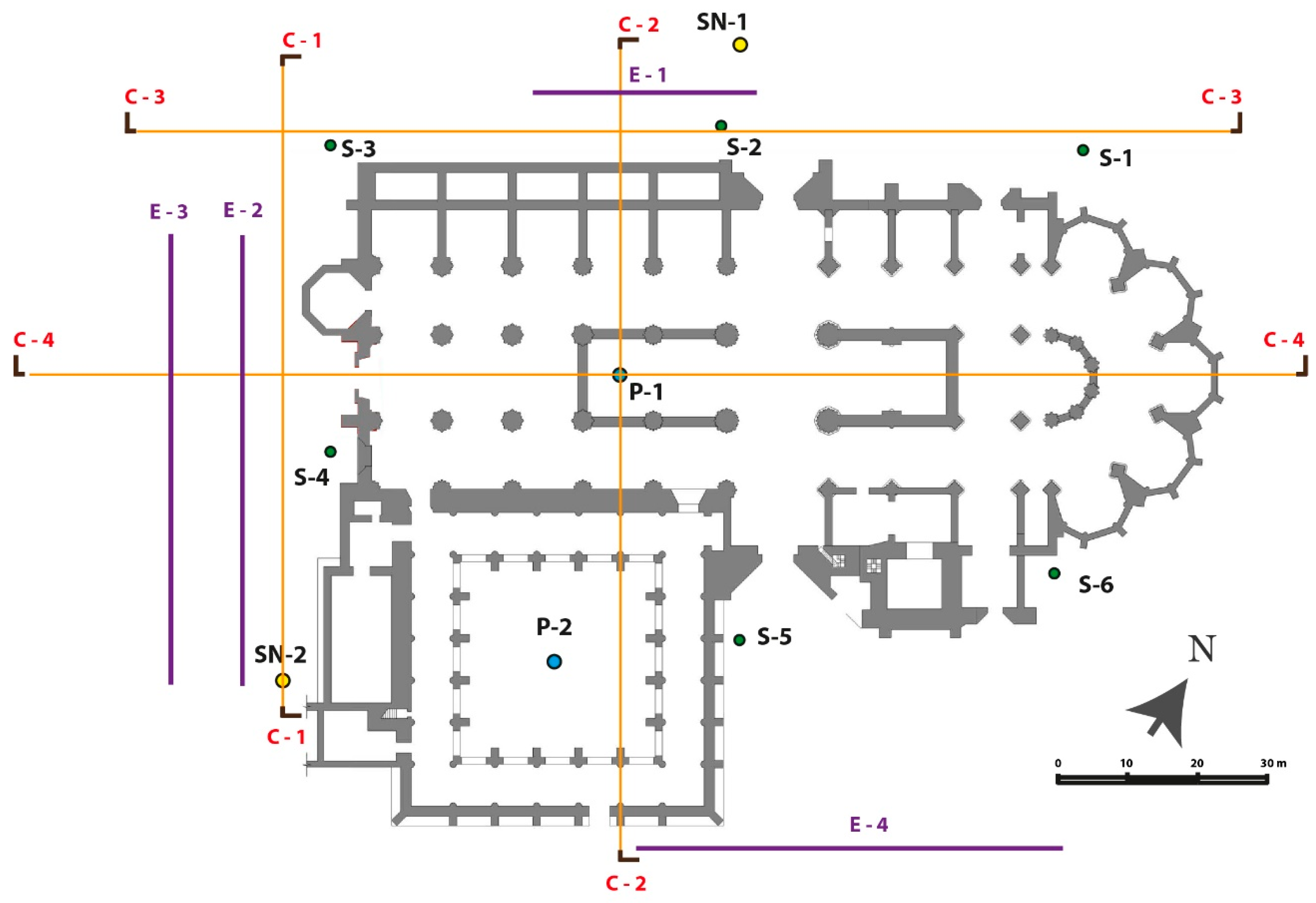
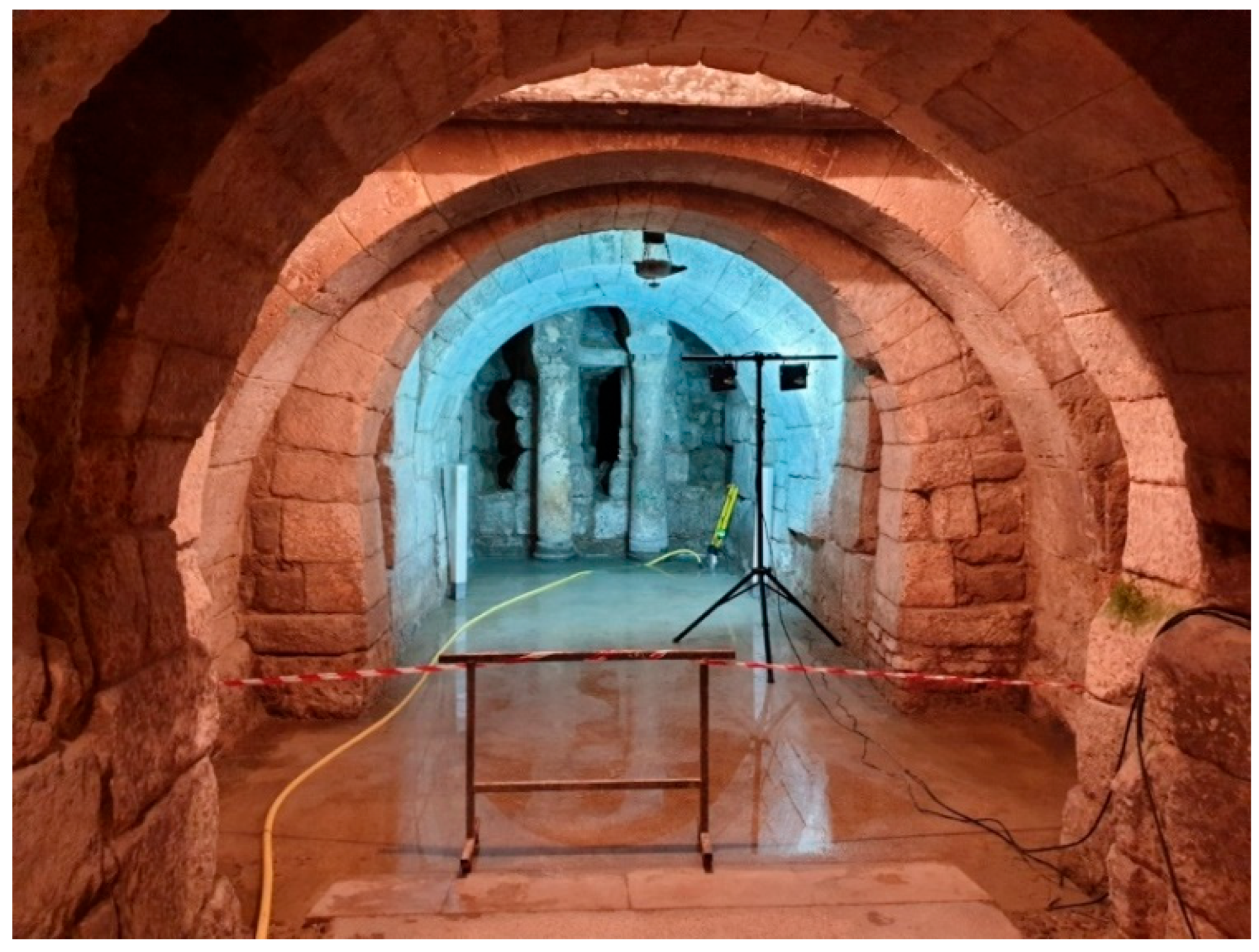
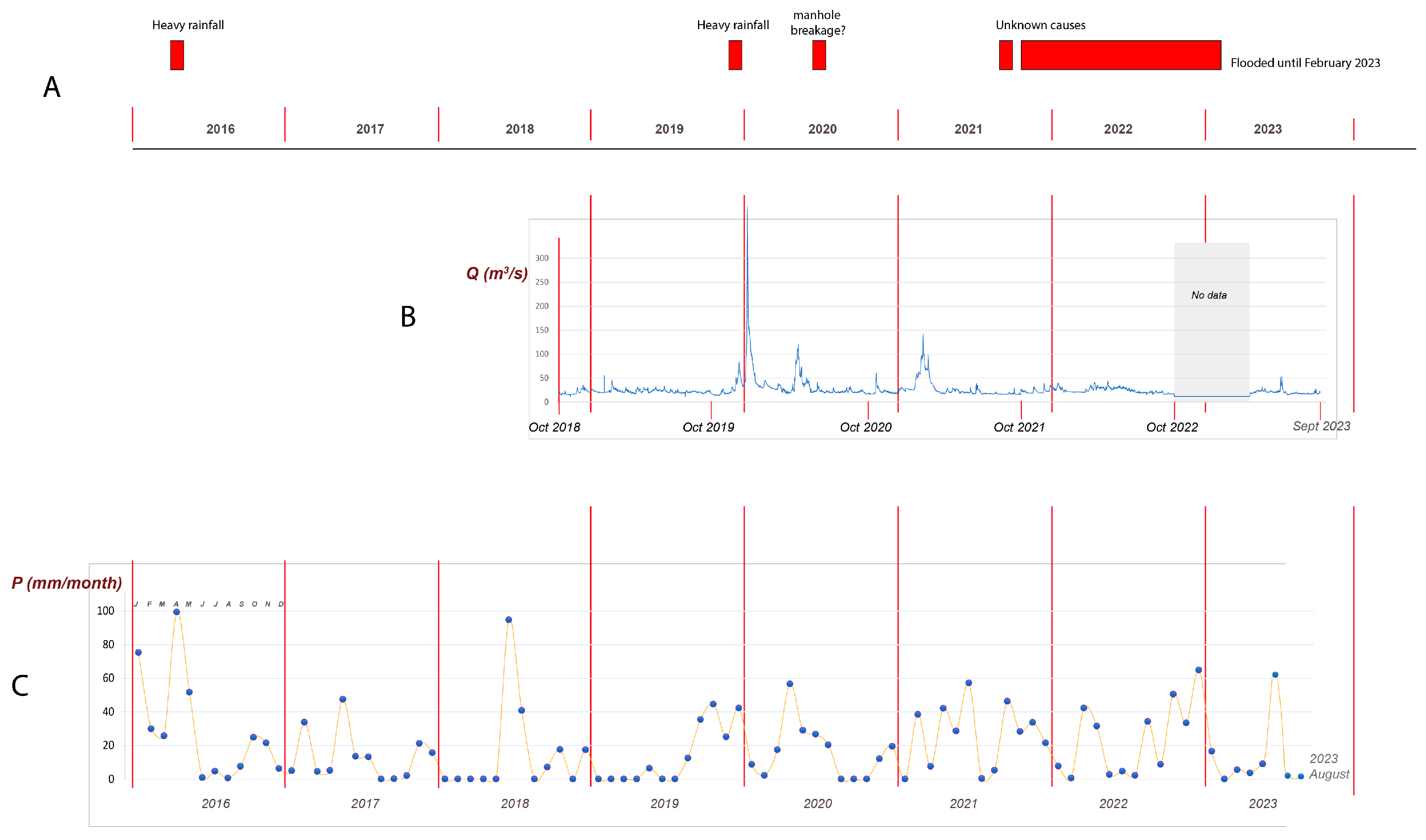


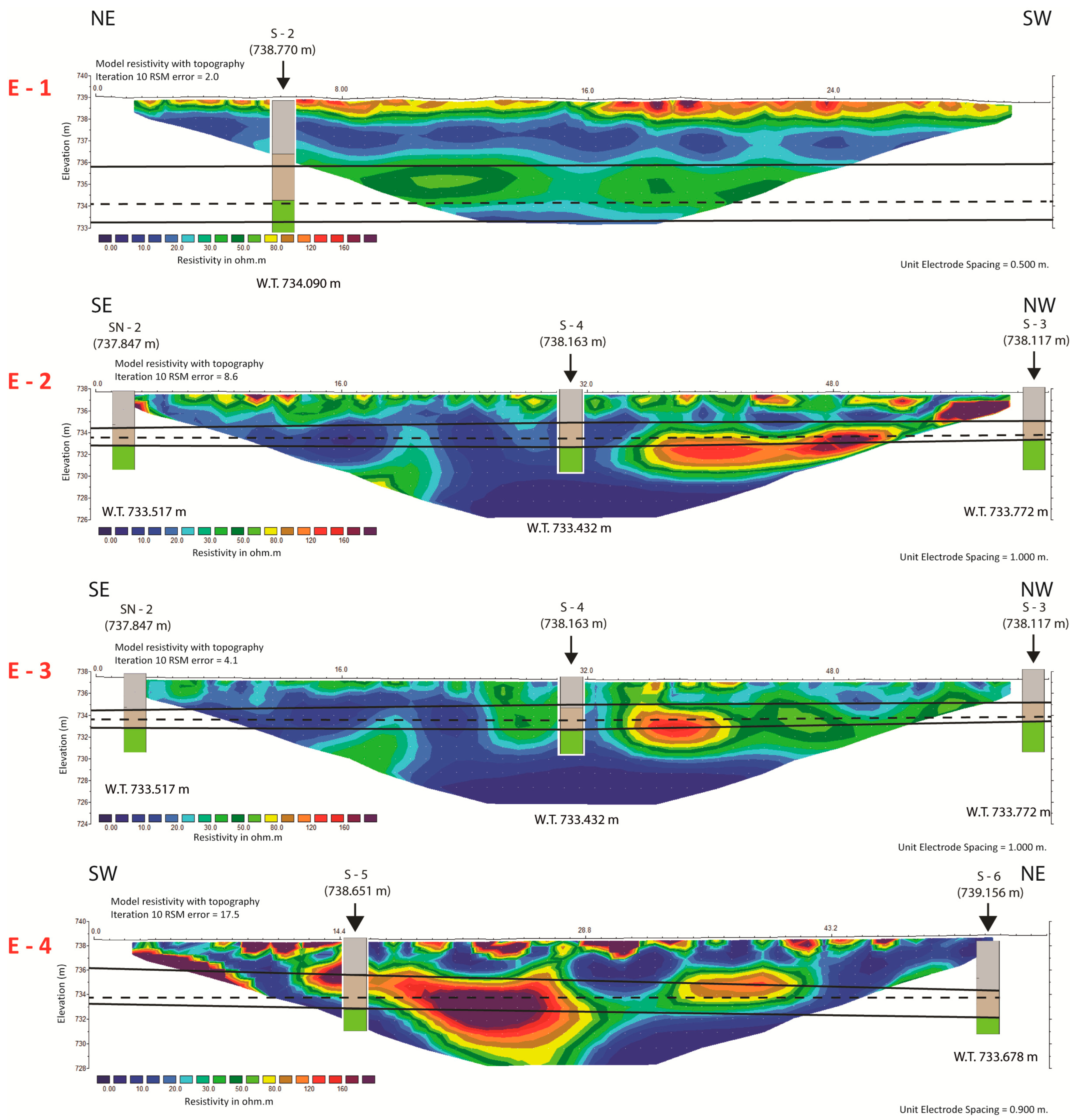


| Profile | Location | Length (m) | Electrode Spacing (m) | Number of Electrodes | Error (%) |
|---|---|---|---|---|---|
| E-1 | Plaza de Cervantes | 31 | 1 | 32 | 2 |
| E-2 | Plaza de San Antolín | 62 | 2 | 32 | 8.6 |
| E-3 | Plaza de San Antolín | 62 | 2 | 32 | 4.1 |
| E-4 | Plaza de la Inmaculada | 55.8 | 1.8 | 32 | 17.5 |
| Survey Point | UTM X | UTM Y | Altitude (m a.s.l.) | Piezometric Level (m a.s.l.) | Anthropogenic Fill—Fluvial Terrace Contact (m a.s.l.) | Anthropogenic Fill Thickness (m) | Fluvial Terrace—Dueñas Unit Contact (m a.s.l.) | Fluvial Terrace Thickness (m) |
|---|---|---|---|---|---|---|---|---|
| S-1 | 372,705.231 | 4,652,221.59 | 739.692 | 734.042 | 735.992 | 3.70 | 732.742 | 3.25 |
| S-2 | 372,692.618 | 4,652,206.55 | 738.770 | - | 735.770 | 3.00 | 732.970 | 2.80 |
| S-3 | 372,646.787 | 4,652,177.99 | 738.117 | 733.772 | 735.117 | 3.00 | 733.397 | 1.72 |
| S-4 | 372,664.753 | 4,652,143.23 | 738.163 | 733.432 | 735.163 | 3.00 | 732.963 | 2.20 |
| S-5 | 372,722.903 | 4,652,150.47 | 738.651 | - | 735.751 | 2.90 | 732.951 | 2.80 |
| S-6 | 372,756.466 | 4,652,177.19 | 739.156 | 733.678 | 735.156 | 4.00 | 733.056 | 2.10 |
| SN-1 | 372,691.476 | 4,652,221.43 | 739.133 | 734.003 | 734.790 | 4.34 | 733.290 | 1.50 |
| SN-2 | 372,670.400 | 4,652,112.73 | 737.847 | 733.517 | 734.961 | 2.89 | 733.361 | 1.60 |
| P-1 | 372,692.529 | 4,652,170.85 | 734.400 | 733.590 | - | - | - | - |
| P-2 | 372,705.231 | 4,652,132.76 | 738.489 | 733.624 | - | - | - | - |
| Crypt | Cloister | S-1 | S-2 | S-3 | S-4 | S-5 | S-6 | SN-1 | SN-2 | |
|---|---|---|---|---|---|---|---|---|---|---|
| 31/07/2003 | - | - | 5.80 | - | - | - | 5.40 | 5.80 | - | - |
| 01/08/2003 | - | - | - | - | - | - | - | - | - | - |
| 04/08/2003 | - | - | 5.80 | 4.70 | 4.25 | 5.00 | 5.20 | 5.70 | - | - |
| 17/09/2003 | - | - | 5.80 | 4.68 | 4.18 | 5.05 | 5.21 | 5.76 | - | - |
| 08/05/2019 | - | - | 4.59 | - | - | - | - | 5.34 | - | - |
| 03/12/2019 | - | - | 4.69 | - | - | - | - | 5.27 | - | - |
| 21/06/2023 | 0.14 | 5.01 | 5.75 | - | 4.25 | 4.72 | - | - | - | - |
| 11/07/2023 | 0.28 | 4.91 | 5.70 | - | 4.41 | 4.81 | - | 4.48 | - | - |
| 27/09/2023 | 0.23 | 4.87 | 5.65 | - | 4.36 | 4.78 | - | 5.43 | 5.13 | 4.33 |
| 16/12/2023 | - | 4.94 | 5.71 | - | 4.18 | - | - | 5.46 | 5.17 | 4.45 |
| 15/04/2024 | 0.20 | 5.00 | 5.45 | - | 4.37 | - | - | - | 5.12 | 4.59 |
| 27/05/2024 | 0.38 | 5.16 | - | - | 4.35 | 5.00 | 5.17 | 5.60 | 5.10 | 4.75 |
Disclaimer/Publisher’s Note: The statements, opinions and data contained in all publications are solely those of the individual author(s) and contributor(s) and not of MDPI and/or the editor(s). MDPI and/or the editor(s) disclaim responsibility for any injury to people or property resulting from any ideas, methods, instructions or products referred to in the content. |
© 2025 by the authors. Licensee MDPI, Basel, Switzerland. This article is an open access article distributed under the terms and conditions of the Creative Commons Attribution (CC BY) license (https://creativecommons.org/licenses/by/4.0/).
Share and Cite
Yenes, M.; Ayarza, P.; Sánchez-Sánchez, Y.; Elez, J.; Palomeras, I.; García-Morales, S.; Ayarza, J.; Yenes, L.; Santamaría-Barragán, A.; Rodríguez-Jiménez, E.; et al. Site Characterization of the Palencia Cathedral (Spain): Origin of Recurrent Phreatic Floods in the Crypt of San Antolín. Heritage 2025, 8, 169. https://doi.org/10.3390/heritage8050169
Yenes M, Ayarza P, Sánchez-Sánchez Y, Elez J, Palomeras I, García-Morales S, Ayarza J, Yenes L, Santamaría-Barragán A, Rodríguez-Jiménez E, et al. Site Characterization of the Palencia Cathedral (Spain): Origin of Recurrent Phreatic Floods in the Crypt of San Antolín. Heritage. 2025; 8(5):169. https://doi.org/10.3390/heritage8050169
Chicago/Turabian StyleYenes, Mariano, Puy Ayarza, Yolanda Sánchez-Sánchez, Javier Elez, Imma Palomeras, Soledad García-Morales, Javier Ayarza, Laura Yenes, Alberto Santamaría-Barragán, Esther Rodríguez-Jiménez, and et al. 2025. "Site Characterization of the Palencia Cathedral (Spain): Origin of Recurrent Phreatic Floods in the Crypt of San Antolín" Heritage 8, no. 5: 169. https://doi.org/10.3390/heritage8050169
APA StyleYenes, M., Ayarza, P., Sánchez-Sánchez, Y., Elez, J., Palomeras, I., García-Morales, S., Ayarza, J., Yenes, L., Santamaría-Barragán, A., Rodríguez-Jiménez, E., Llera, L., & Gómez-Barreiro, J. (2025). Site Characterization of the Palencia Cathedral (Spain): Origin of Recurrent Phreatic Floods in the Crypt of San Antolín. Heritage, 8(5), 169. https://doi.org/10.3390/heritage8050169







